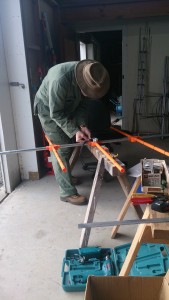There were some equipment issues on the 27th and 28th of September, as well as the 9th and 11th of October so these days do not contain the full 24 hours worth of data, as the software was not recording continuously on these days. The software, SDR# has a tendency to crash from time to time, usually after connecting to the computer to check that the noise floor has not dropped or increased. On 27th of September, I checked the program once just before noon and it was only the next day in the morning that I noticed that there were no files downloading in the DropBox throughout the day and over night. After connecting to the computer to see if it was still working, I saw that the program was not responding and I had to restart it. Since it seems that it was not be responding for most of the day of the 27th and over night on the 28th of September, no signals were detected and recorded and therefore those two days are also missing some data. The same thing again happened on the 9th of October, but I checked the program at around 10pm so only the data during the day from about noon until 10pm is missing. Seeing as those are approximately the times when there are the least amount of meteors entering our atmosphere, I can assume that majority of the signals for the 9th of October were recorded and only a few were missed.
A few days before the 11th of October, the noise floor started varying a lot and many false positive files were recorded that filled up the DropBox to its capacity. On the 11th of October, overnight, the noise floor dropped by a further 2dB and no files were recorded – both signals and random, varying peaks were missed. I made a decision to drive out to Ardmore with a USB stick to manually transfer the data from the computer to my laptop, which I used for analysing the data, and also check the equipment to see why the noise floor was varying so much. I checked all of the connections to see if anything had come loose and thus became a source of extra noise, including the connections inside of the balun of the antenna. After I checked the balun, the random peaks disappeared and the significant varying of the noise floor stopped and there was also an increase in signal detection. This could indicate that the connections inside the balun had either come loose throughout the project, maybe due to storms and wind at the location, or they were never properly screwed in from the beginning. I got in touch with a technician about the loose connection and this is currently in the process of being fixed. The increase in signal detection could also be due to the increased meteor activity from the Orionids meteor shower.
Since the onset of the project, a new version of the receiver has been released, called Airspy R2 so in the future, it might be useful to look into investing into the new receiver to see if it would increase the sensitivity of the equipment and be able to detect even more faint signals. A signal amplifier could be added to the antenna to amplify any low power signals, allowing for them to also be recorded. However, an amplifier could amplify the noise as well, thus looking into shielding the receiver would be necessary if an amplifier was to be added. A filter could also be added if wished, but it is not necessary as there is a frequency setting in the software that allows only the target frequency to trigger recording.
It has been very exciting and interesting to work on this project this year and I hope that next year someone will take over and carry on improving my set up and observing and recording meteor activity here in New Zealand.











